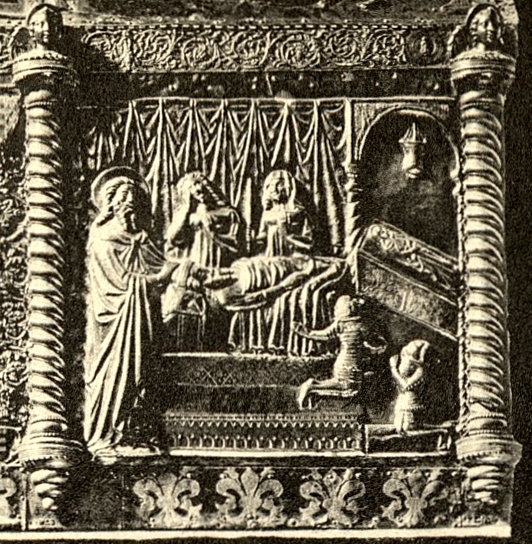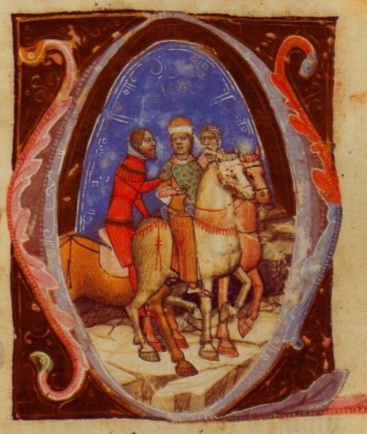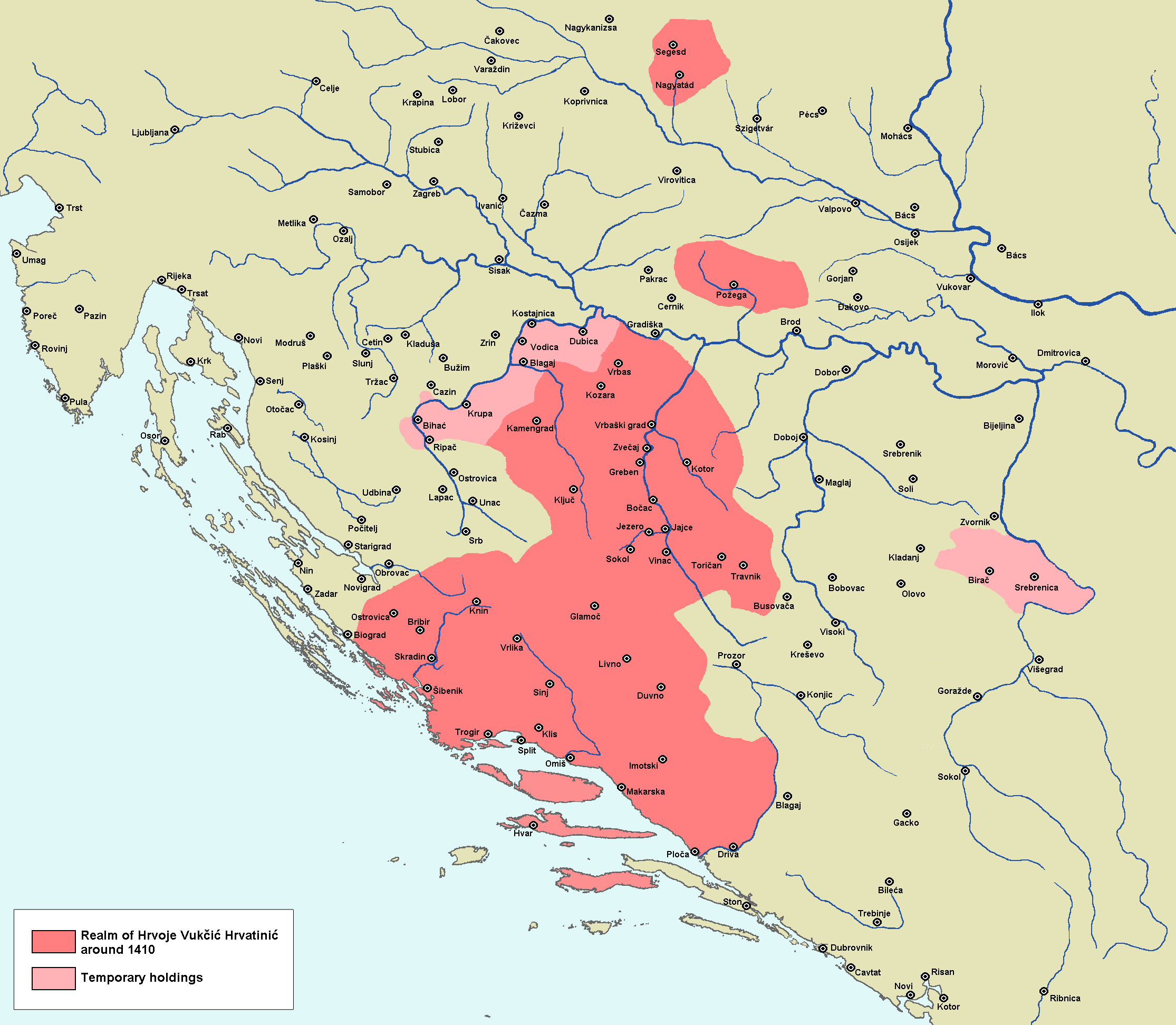|
Vladislav Kotromanic
Vladislav of Bosnia ( sh-Latn-Cyrl, separator=/, Vladislav Kotromanić, Владислав Котроманић; died 1354) was a member of the House of Kotromanić who effectively ruled the Banate of Bosnia from September 1353 to his death. Vladislav was a younger son of Stephen I, Ban of Bosnia, and Elizabeth of Serbia. Upon the death of Ban Stephen I in 1314, Vladislav's mother assumed regency in the name of his older brother, Ban Stephen II. Unclear circumstances soon forced her to flee Bosnia and seek refuge in the Republic of Ragusa. She took her children with her, and Ragusan documents show they spent several years there in exile. The 16th-century chronicler Mavro Orbini states that only Stephen followed Elizabeth, while Vladislav and his brother Ninoslav went to the Croatian town of Medvedgrad. By the summer of 1319, the Kotromanić family were back in Bosnia. Vladislav and Stephen took part in a great coalition of noblemen against their overlord Mladen II Šubić ... [...More Info...] [...Related Items...] OR: [Wikipedia] [Google] [Baidu] |
Tvrtko I Of Bosnia
Stephen Tvrtko I ( sh-Latn-Cyrl, separator=" / ", Stjepan/Stefan Tvrtko, Стјепан/Стефан Твртко; 1338 – 10 March 1391) was the first king of Bosnia. A member of the House of Kotromanić, he succeeded his uncle Stephen II as Ban of Bosnia in 1353. As he was a minor at the time, Tvrtko's father, Vladislav, briefly ruled as regent, followed by Tvrtko's mother, Jelena. Early in his personal rule, Tvrtko quarreled with his country's Roman Catholic clergy, but later enjoyed cordial relations with all the religious communities in his realm. After initial difficulties – the loss of large parts of Bosnia to his overlord, King Louis I of Hungary, and being briefly deposed by his magnates – Tvrtko's power grew considerably. He conquered some remnants of the neighbouring Serbian Empire in 1373, after the death of its last ruler and his distant relative, Uroš the Weak. In 1377, he had himself crowned king of Bosnia and of Serbia, claiming to be the heir of Serbia' ... [...More Info...] [...Related Items...] OR: [Wikipedia] [Google] [Baidu] |
Charles I Of Hungary
Charles I, also known as Charles Robert ( hu, Károly Róbert; hr, Karlo Robert; sk, Karol Róbert; 128816 July 1342) was King of Hungary and Croatia from 1308 to his death. He was a member of the Capetian House of Anjou and the only son of Charles Martel, Prince of Salerno. His father was the eldest son of Charles II of Naples and Mary of Hungary. Mary laid claim to Hungary after her brother, Ladislaus IV of Hungary, died in 1290, but the Hungarian prelates and lords elected her cousin, Andrew III, king. Instead of abandoning her claim to Hungary, she transferred it to her son, Charles Martel, and after his death in 1295, to her grandson, Charles. On the other hand, her husband, Charles II of Naples, made their third son, Robert, heir to the Kingdom of Naples, thus disinheriting Charles. Charles came to the Kingdom of Hungary upon the invitation of an influential Croatian lord, Paul Šubić, in August 1300. Andrew III died on 14 January 1301, and within four mon ... [...More Info...] [...Related Items...] OR: [Wikipedia] [Google] [Baidu] |
14th-century Bosnian People
As a means of recording the passage of time, the 14th century was a century lasting from 1 January 1301 ( MCCCI), to 31 December 1400 (MCD). It is estimated that the century witnessed the death of more than 45 million lives from political and natural disasters in both Europe and the Mongol Empire. West Africa experienced economic growth and prosperity. In Europe, the Black Death claimed 25 million lives wiping out one third of the European population while the Kingdom of England and the Kingdom of France fought in the protracted Hundred Years' War after the death of Charles IV, King of France led to a claim to the French throne by Edward III, King of England. This period is considered the height of chivalry and marks the beginning of strong separate identities for both England and France as well as the foundation of the Italian Renaissance and Ottoman Empire. In Asia, Tamerlane (Timur), established the Timurid Empire, history's third largest empire to have been eve ... [...More Info...] [...Related Items...] OR: [Wikipedia] [Google] [Baidu] |
1354 Deaths
Year 1354 ( MCCCLIV) was a common year starting on Wednesday A common year starting on Wednesday is any non-leap year (a year with 365 days) that begins on Wednesday, 1 January, and ends on Wednesday, 31 December. Its dominical letter hence is E. The most recent year of such kind was 2014, and the next one ... (link will display the full calendar) of the Julian calendar. Events January–December * Early in the year – Ibn Battuta returns from his travels at the command of Abu Inan Faris, sultan of Morocco, who appoints a scribe to write an account of the adventures. * February 12 – The Treaty of Stralsund (1354), Treaty of Stralsund settles border disputes between the duchies of Mecklenburg and Pomerania. * March 2 – The Gallipoli earthquake occurs, followed within a month by Turkish capture and settlement, the Fall of Gallipoli. * October 8 – Cola di Rienzo, self-proclaimed "tribune" of Rome, is killed by an angry mob. * December 10 &ndash ... [...More Info...] [...Related Items...] OR: [Wikipedia] [Google] [Baidu] |
14th-century Viceregal Rulers
As a means of recording the passage of time, the 14th century was a century lasting from 1 January 1301 ( MCCCI), to 31 December 1400 ( MCD). It is estimated that the century witnessed the death of more than 45 million lives from political and natural disasters in both Europe and the Mongol Empire. West Africa experienced economic growth and prosperity. In Europe, the Black Death claimed 25 million lives wiping out one third of the European population while the Kingdom of England and the Kingdom of France fought in the protracted Hundred Years' War after the death of Charles IV, King of France led to a claim to the French throne by Edward III, King of England. This period is considered the height of chivalry and marks the beginning of strong separate identities for both England and France as well as the foundation of the Italian Renaissance and Ottoman Empire. In Asia, Tamerlane (Timur), established the Timurid Empire, history's third largest empire to have been ever establish ... [...More Info...] [...Related Items...] OR: [Wikipedia] [Google] [Baidu] |
14th-century Rulers In Europe
As a means of recording the passage of time, the 14th century was a century lasting from 1 January 1301 ( MCCCI), to 31 December 1400 ( MCD). It is estimated that the century witnessed the death of more than 45 million lives from political and natural disasters in both Europe and the Mongol Empire. West Africa experienced economic growth and prosperity. In Europe, the Black Death claimed 25 million lives wiping out one third of the European population while the Kingdom of England and the Kingdom of France fought in the protracted Hundred Years' War after the death of Charles IV, King of France led to a claim to the French throne by Edward III, King of England. This period is considered the height of chivalry and marks the beginning of strong separate identities for both England and France as well as the foundation of the Italian Renaissance and Ottoman Empire. In Asia, Tamerlane (Timur), established the Timurid Empire, history's third largest empire to have been ever establish ... [...More Info...] [...Related Items...] OR: [Wikipedia] [Google] [Baidu] |
Vassals
A vassal or liege subject is a person regarded as having a mutual obligation to a lord or monarch, in the context of the feudal system in medieval Europe. While the subordinate party is called a vassal, the dominant party is called a suzerain. While the rights and obligations of a vassal are called vassalage, and the rights and obligations of a suzerain are called suzerainty. The obligations of a vassal often included military support by knights in exchange for certain privileges, usually including land held as a tenant or fief. The term is also applied to similar arrangements in other feudal societies. In contrast, fealty (''fidelitas'') was sworn, unconditional loyalty to a monarch. European vassalage In fully developed vassalage, the lord and the vassal would take part in a commendation ceremony composed of two parts, the homage and the fealty, including the use of Christian sacraments to show its sacred importance. According to Eginhard's brief description, the ''commenda ... [...More Info...] [...Related Items...] OR: [Wikipedia] [Google] [Baidu] |
Papacy
The pope ( la, papa, from el, πάππας, translit=pappas, 'father'), also known as supreme pontiff ( or ), Roman pontiff () or sovereign pontiff, is the bishop of Rome (or historically the patriarch of Rome), head of the worldwide Catholic Church, and has also served as the head of state or sovereign of the Papal States and later the Vatican City State since the eighth century. From a Catholic viewpoint, the primacy of the bishop of Rome is largely derived from his role as the apostolic successor to Saint Peter, to whom primacy was conferred by Jesus, who gave Peter the Keys of Heaven and the powers of "binding and loosing", naming him as the "rock" upon which the Church would be built. The current pope is Francis, who was elected on 13 March 2013. While his office is called the papacy, the jurisdiction of the episcopal see is called the Holy See. It is the Holy See that is the sovereign entity by international law headquartered in the distinctively independent Vatican ... [...More Info...] [...Related Items...] OR: [Wikipedia] [Google] [Baidu] |
Bishop Of Trogir
Tragurium, Ancient Latin name of a city in Dalmatia (coastal Croatia), now called Trogir, was a bishopric until 1829 and a Latin titular bishopric until 1933."Diocese of Trogir (Traù)" ''''. David M. Cheney. Retrieved February 29, 2016"Titular Episcopal See of Trogir" ''GCatholic.org''. Gabriel Chow. Retrieved February 29, 2016 History In 1050 Tragurium became the seat of a |
George II Šubić Of Bribir
}; 1275 – Klis, 15 December 1328) was Croatian nobleman, a member of the Šubić noble family, who ruled from the Klis Fortress. Early life George II Šubić was son of Paul I Šubić of Bribir, who was the most powerful Croatian nobleman at the end of the 13th century and beginning of the 14th century. After the capture of his brother Mladen II Šubić, George II became the head of the Šubić family with support of his two remaining brothers: Gregory I Šubić and Paul II Šubić. Career When George I died in 1303, his nephew George II succeeded him as ruler in Dalmatia. When Paul I died in May 1312, Mladen II succeeded as Ban of Croatia and Dalmatia, and he shared out his cities to his brothers: Gregory received Šibenik and Bribir, while George II received Omiš, Nin and Klis. George II tried to retake the land and influence that his brother, Mladen II Šubić, had lost in the last war over Bosnia. But he didn't claim Bosnia, instead, he pursued the conquest of lands in ... [...More Info...] [...Related Items...] OR: [Wikipedia] [Google] [Baidu] |
Hrvatinić Noble Family
House of Hrvatinić was a Bosnian medieval noble family that emerged in Donji Kraji county, located in today's territory of western Bosnia and Herzegovina. Principally they were vassals to Kotromanić dynasty of the Banate of Bosnia and Kingdom of Bosnia, occasionally also to the Kingdom of Hungary, changing loyalties between Hungarian kings Ladislaus of Naples and Sigismund of Luxembourg, and finally the Ottoman Empire (1472–1476). They rose to prominence in the second half of the 14th century, and attained its peak under magnate Hrvoje Vukčić Hrvatinić (1350–1416), who also held large swaths of Dalmatia and obtained title of Grand Duke of Bosnia in 1380. Its eponymous founder was Hrvatin Stjepanić ( 1299–1304), a count and holder of possession in parts of " Donji Kraji" ( en, Lower Ends) and "Zapadne Strane" ( en, "Western Sides"), and a vassal of Croatian magnate Paul I Šubić of Bribir. Hrvatin's sons was part of a coalition of Bosnian and Slavonian nobil ... [...More Info...] [...Related Items...] OR: [Wikipedia] [Google] [Baidu] |








